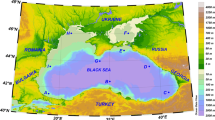Abstract
We compared data of sea surface wind from the European Centre for Medium-Range Weather Forecasts Interim Reanalysis (ERA-Interim) with that collected from eight buoys deployed in the Yellow and East China seas. The buoy data covered a period from 2010 to 2011, during which the longest time series without missing data extended for 329 days. Results show that the ERA-Interim wind data agree well with the buoy data. The regression coefficients between the ERA-Interim and observed wind speed and direction are greater than 0.7 and 0.79, respectively. However, the ERA-Interim wind data overestimate wind speed at most of the buoy stations, for which the largest bias is 1.8 m/s. Moreover, it is found from scatter plots of wind direction that about 13% of the ERA-Interim wind data can be classified as bad for wind speeds below 6 m/s. Overall, the ERA-Interim data forecast both the wind speed and direction well, although they are not very representative of our observations, especially those where the wind speed is below 6 m/s.
Similar content being viewed by others
References
Brennan M J, Cobb III H D, Knabb R D. 2010. Observations of Gulf of Tehuantepec gap wind events from QuikSCAT: an updated event climatology and operational model evaluation. Wea. Forecasting, 25(2): 646–658.
Carton J A, Giese B S. 2008. A reanalysis of ocean climate using Simple Ocean Data Assimilation (SODA). Mon. Wea. Rev., 136(8): 2 999–3 017.
Cavaleri L, Bertotti L. 2004. Accuracy of the modelled wind and wave fields in enclosed seas. Tellus A, 56(2): 167–175.
Chelton D B, Freilich M H. 2005. Scatterometer-based assessment of 10-m wind analyses from the operational ECMWF and NCEP numerical weather prediction models. Mon. Wea. Rev., 133: 409–429.
Cotton J. 2009. A comparison of QuikSCAT with buoy, ship and radar altimeter wind speeds and evaluating the need for a new bias correction. Met Office, Met R&D Technical Report 538.
Dee D P, Uppala S M, Simmons A J et al. 2011. The ERAInterim reanalysis: configuration and performance of the data assimilation system. Quarterly J. Royal Meteor. Soc., 137(656): 553–597.
Dong C, Oey L Y. 2005. Sensitivity of coastal currents near Point Conception to forcing by three different winds: ECMWF, COAMPS, and blended SSM/I-ECMWF-Buoy winds. J. Phys. Oceanogr., 35(7): 1 229–1 244.
Fan X, Walsh J E, Krieger J R. 2008. A one-year experimental Arctic reanalysis and comparisons with ERA-40 and NCEP/NCAR reanalyses. Geophys. Res. Lett., 35(19).
Liu Z, Song L, Wang F, Bai H. 2012. Comparison between QuikSCAT and buoy wind data in the north Yellow Sea, Marine Sci., 36: 1–7. (in Chinese with English abstract)
Parekh A, Sharma R, Sarkar A. 2007. A comparative assessment of surface wind speed and sea surface temperature over the Indian Ocean by TMI, MSMR, and ERA-40. J. Atmos. Oceanic Technol., 24(6): 1 131–1 142.
Pickett M H, Tang W, Rosenfeld L K, Wash C H. 2003. QuikSCAT satellite comparisons with nearshore buoy wind data off the US west coast. J. Atmos. Oceanic Technol., 20(12): 1 869–1 879.
Satheesan K, Sarkar A, Parekh A, Kumar M R, Kuroda Y. 2007. Comparison of wind data from QuikSCAT and buoys in the Indian Ocean. Int. J. Remote Sens., 28(10): 2 375–2 382.
Xie S P, Hafner J, Tanimoto Y, Liu W T, Tokinaga H, Xu H. 2002. Bathymetric effect on the winter sea surface temperature and climate of the Yellow and East China Seas. Geophys. Res. Lett., 29(24): 81-1–81-4.
Yang D, Yin B, Liu Z, Bai T, Qi J, Chen H. 2012. Numerical study on the pattern and origins of Kuroshio branches in the bottom water of southern East China Sea in summer. J. Geophys. Res.: Oceans (1978–2012), 117(C2), http://dx.doi.org/10.1029/2011JC007528.
Yang D, Yin B, Liu Z, Feng X. 2011. Numerical study of the ocean circulation on the East China Sea shelf and a Kuroshio bottom branch northeast of Taiwan in summer. J. Geophys. Res.: Oceans (1978–2012), 116(C5), http://dx.doi.org/10.1029/2010JC006777.
Zou L, Zhou T, Li L, Zhang J. 2010. East China summer rainfall variability of 1958–2000: dynamical downscaling with a variable-resolution AGCM. J. Climate, 23(23): 6 394–6 408.
Author information
Authors and Affiliations
Corresponding author
Additional information
Supported by the National Natural Science Foundation of China (No. 41276026), the Ocean Special Project (No. XDA11020301), and the National Basic Research Program of China (973 Program) (No. 2009CB421205)
Rights and permissions
About this article
Cite this article
Song, L., Liu, Z. & Wang, F. Comparison of wind data from ERA-Interim and buoys in the Yellow and East China Seas. Chin. J. Ocean. Limnol. 33, 282–288 (2015). https://doi.org/10.1007/s00343-015-3326-4
Received:
Accepted:
Published:
Issue Date:
DOI: https://doi.org/10.1007/s00343-015-3326-4



